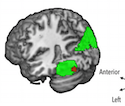Abstract
Attention deficit hyperactivity disorder (ADHD) is strongly affected by sex, but sex chromosomes’ effect on brain attention networks and cognition are difficult to examine in humans. This is due to significant etiologic heterogeneity among diagnosed individuals. In contrast, individuals with Turner syndrome (TS), who have substantially increased risk for ADHD symptoms, share a common genetic risk factor related to the absence of the X-chromosome, thus serving as a more homogeneous genetic model. Resting-state functional MRI was employed to examine differences in attention networks between girls with TS (n = 40) and age- sex- and Tanner-matched controls (n = 33). We compared groups on resting-state functional connectivity measures from data-driven independent components analysis (ICA) and hypothesis-based seed analysis. Using ICA, reduced connectivity was observed in both frontoparietal and dorsal attention networks. Similarly, using seeds in the bilateral intraparietal sulcus (IPS), reduced connectivity was observed between IPS and frontal and cerebellar regions. Finally, we observed a brain-behavior correlation between IPS-cerebellar connectivity and cognitive attention measures. These findings indicate that X-monosomy contributes affects to attention networks and cognitive dysfunction that might increase risk for ADHD. Our findings not only have clinical relevance for girls with TS, but might also serve as a biological marker in future research examining the effects of the intervention that targets attention skills.
